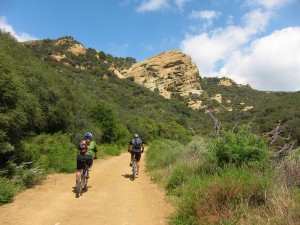California State Parks will be performing maintenance on all fire roads throughout the park. The project is underway and will take several weeks. This is considered routine maintenance, to restore the fire roads to their intended purpose, as well as to prevent further degradation of the roads and impacts to the environment.

Eagle Springs Loop now undergoing road maintenance
Every time maintenance of this type is done, we know that there are many experienced mountain bikers who don’t like the changes. Having our favorite “challenging sections” smoothed over often comes as a surprise. On the other hand, some riders welcome the improvements. But regardless, the fire roads will change.
Why is this being done? Fire roads are primarily transportation corridors for fire fighting, emergency vehicle access, administrative work within the parks, and for recreation. Over time, all dirt fire roads degrade and begin to develop ruts and water channels form. Once the ruts begin to form, rain will then extend and deepen those ruts. This creates additional challenge for cyclists, but it also makes it more difficult for the State Parks administration to do their job of managing the park. Their primary mission is to preserve the park and it’s natural resources for us and our future generations.
Currently fire road maintenance work is being done on the Eagle Springs loop to repair existing damage, reduce future maintenance needs, and to provide additional protection of the environment. The Regional Water Quality Control Board mandates State Parks and other land managers to reduce sediments washed into the creeks and streams. Studies have demonstrated that fire roads are major contributors to this problem. State Parks had to determine which fire roads were causing the most erosion and sediment runoff in both Malibu Creek State Park and Topanga State Park. They have identified Eagle Springs loop as a priority project.
State Parks are currently outsloping as many areas of the roads as possible. We always try to outslope trails when we do trail maintenance. Outsloping helps shed water off the trail or road. Insloped roads carry and channel water and the more water carried causes more erosion. In some particularly bad areas in Topanga State Park, roads have lost about five feet of material across the whole eighteen feet of width of the road.
The sediment washed off these roads heavily impacts streams and creeks in the parks as it makes its way to Santa Monica Bay. On a state-wide basis State Parks has turned to outsloping all back country roads and trails. This has shown to reduce erosion and be a more sustainable maintenance practice. In the long run sediment runoff will be greatly reduced, further protecting the streams, creeks and the environment as a whole.
Eagle Rock Fire Road was given the highest priority in Topanga since it showed the heaviest erosion. It was no longer accessible by vehicles. It was also causing damage and erosion on Musch Trail, which joins the road.
State Parks appreciates your understanding, and CORBA, supports their efforts to reduce impacts to the environment. We all want to protect the places we play and ride. If that means grading over a section of road to make it more sustainable, we’re fine with that. The alternative is to decommission the road and close it to all users, something none of want to see.
During and for some time after construction, the roads will not be very pretty, and may be soft and loose until the tread gets packed down. In time, they’ll return to a more natural looking state. Most mountain bike injuries occur on fire roads, due to the ease with which we can gain speed. So as we ride these newly graded roads, remember to be safe, and that there is a 15mph speed limit on all trails and fire roads within the Santa Monica Mountains National Recreation Area.
Tags: fire roads, road maintenance




I was on Eagle Springs Fire Road last Sunday, between Hub Junction and Eagle Junction. The bulldozer work that had been done there seemed extremely heavy-handed and haphazard. It was widened a great deal in some places, but still narrow in others. There didn’t seem to be any rhyme or reason to it, but it sure chewed up a lot of vegetation and looked like hell. Was someone on a bender?
Hi David,
Thanks for your concern. Unless you’re a road and trails engineer, you’re probably not going to fully fathom the kind of work that goes on with regard to fire road engineering. Believe it or not, it has been MANY years since most of the fire roads in Topanga State Park have undergone any serious reconfiguring (Rogers Road Trail being the exception as it underwent a major overhaul a couple of years ago). As you probably are aware, there was some devastating hyrdo-erosion on the section of trail leading west away from Eagle Rock, as well as some pretty heavy erosion along the Eagle Springs trail up to The Hub. The trail engineers are attempting to create a long-overdue sloping of the fire roads that better channel water so that the kind of erosion doesn’t happen again–or at least not for several years. I know it looks ugly (and it’s not much fun to ride on), but it is a common activity on our trails and we just have to live with it. Soon enough the trails will once again become compacted and likely there will also be some ruts that will develop, making the fire roads more “interesting”.
-Mark Langton